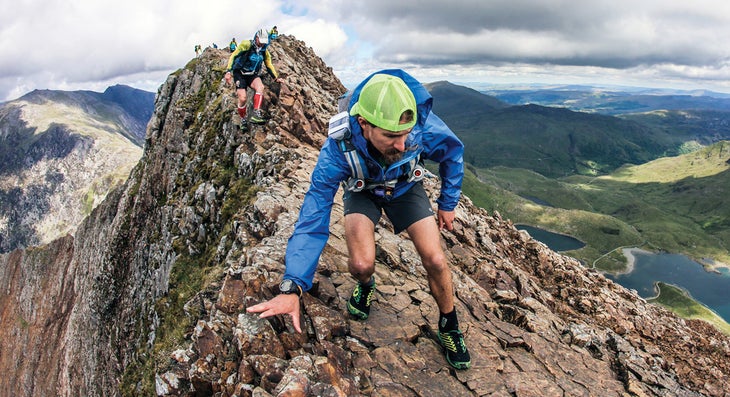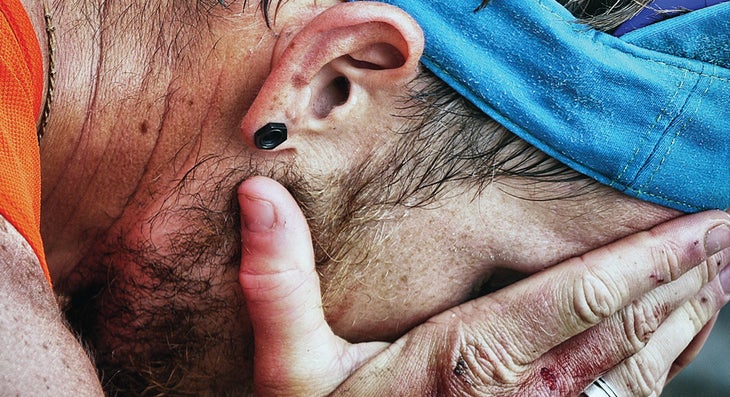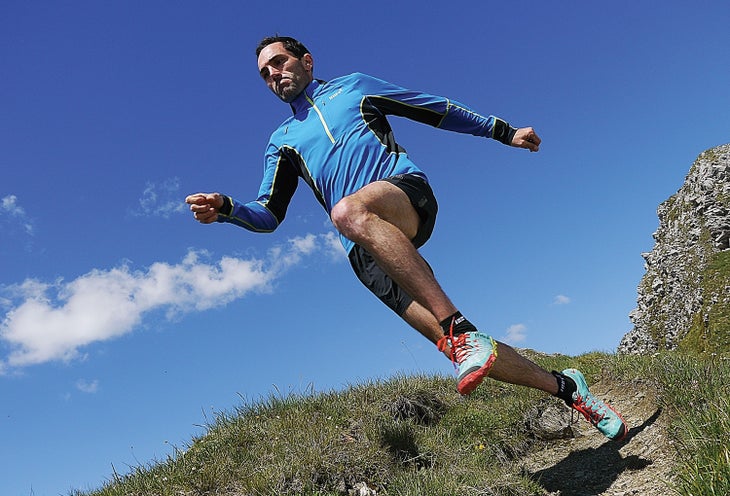New perk! Get after it with local recommendations just for you. Discover nearby events, routes out your door, and hidden gems when you sign up for the Local Running Drop.
It’s easy to idealize running.
Frolicking through forests! Jumping over rocks and bounding down mountains! On a training plan, the miles come so easily. But that’s not reality.
As a coach, I try to never lose sight of that fact. It’s so easy to write down “8 mile run” and not think about what that actually entails. That’s more than 10,000 steps, each one with significantly more impact forces than walking, each one with the potential to go horribly wrong. That training log entry seems simple, but it’s asking an athlete to do something that many people can’t do in the first place.
Our heads may be up in the clouds, but our bodies are on the ground, and they can feel the pounding. The process of building up endurance risks breakdown with each step. Running is a lot like life in that way. Every day that passes brings us one day closer to the ultimate breakdown.
What can we do in the face of our own fragility? We can keep moving forward.
That sounds melodramatic. I promise this article will not be too serious. But it is important to understand that we get running injuries for the same reasons that we die—our bodies are only capable of so many miles, even if our brains can expand to encompass infinity. Just as life requires death to have meaning, so too do runners have to get injured for the miles to be more than numbers in a training log.
So let’s celebrate the whole journey, including the parts that might be less fun to talk about. Let’s talk injuries.
To understand injuries, we need to take a step back and think about the purpose of running training.
What happens when you go for a run? The answer: nothing good.
As you run farther and with more intensity, your body experiences cellular-level breakdown and system-level fatigue. That’s why you finish your long run ready to collapse into a pile of pancakes. Your body is undergoing fundamental deformations that reduce its current capacity.
Then the good stuff happens. Your body adapts to that stimulus, building back stronger. Push a bit too far, and the breakdown doesn’t lead so simply to adaptation. This interconnected process of adaptation and injury is most clear for bone.
As you run, bone cells and networks of cells undergo stress. Over time, that can lead to extremely strong brontosaurus bones. In bone-density scans of healthy runners, I have seen some astronomically high relative densities in shins and femurs.
But what if the stress goes just a bit too far? In the moment, it’s probably tough to know. Maybe it starts aching slightly a week or two later, the whispers of a stress reaction. Maybe it waits to become a sharp pain a month later, the screams of a stress fracture. The same thing that creates strong bones that can withstand countless miles causes breaks that make a single mile impossible. And it’s darn near impossible to know where the line between adaptation and injury lies.
Stress plus rest equals adaptation is a complicated equation.
Good training and self-destructive training often look similar, because there are unknown variables in the stress-and-rest equation. As much as we want to have control, we can’t really measure all of the stress in a complex life.
It gets back to one of the most frustrating elements of running training and coaching. The body doesn’t know miles; it knows stress. What seems like a carefree, easy eight miles could actually be more like running 20 hard miles if it’s coming near a hard work presentation, or a late night feeding a baby, or a generalized bout of anxiety about existence. An interval workout is hard, an existential crisis is harder, and the body doesn’t distinguish much between the two.
The same principle applies to rest. A pro athlete might take a nap, sleep 12 hours and get a back massage from a litter of soft golden retriever puppies (if running coaching doesn’t work out, I call dibs on that start-up idea). A parent might sleep four hours and get yelled at by a crappy boss (that boss should try Spuppy, my new puppy-massage spa). Our brains like to simplify the adaptation equation, but every honest training plan would come with a disclaimer—“I think this should work, maybe, but who the heck knows?”
Overuse injuries don’t always have obvious causes.
The clearest example of the adaptation equation breaking down is when the body rebels with overuse injuries. Run a lot, maybe a little too hard, and you get hurt. Duh, of course that happens, running is hard on the body. As your neighbor who hasn’t walked a mile since the first Bush administration says, “Aren’t you worried about your knees?”
It’s not that simple, though. Overuse injuries can happen when athletes do everything right, precipitated by a tough day at work as much as a tough interval workout. Or maybe it’s a chronic-on-acute injury, where an initial ankle sprain causes a future stress fracture in a bone near the ankle that was weakened. Injured athletes are often filled with regret and self loathing, but overuse injuries can just be unlucky spins on the Universe’s roulette wheel.
Plus, overuse injuries are the necessary flip side of pushing your limits. Your sedentary neighbor probably doesn’t have a tibial stress fracture or hip tendonitis, and that’s because their hardest workout is bicep curls with the remote control. If you go for it in an athletic life, injuries are an inevitable consequence at some point.
Traumatic injuries are totally unpredictable.
Sometimes, though, it’s just crappy luck. Here is a list of the worst traumatic running injuries I have seen:
• compound tibia fracture from a trail running fall,
• ruptured hamstring from stepping in a prairie-dog hole,
• broken ankle from hitting a rock on a switchback,
• broken toe from banging it in the sauna,
• deep thigh laceration from running into a tree.
I stopped myself there, but I could go on all day, with photos too. The amazing editors of Trail Runner wouldn’t put those in the magazine, so I suggest sending them a donation in gratitude.
Or it can be acute-on-chronic injuries. An underlying weakness caused by a bit too much stress opens up the body to be more susceptible to trauma. It might be as simple as lower bone density from training hard while not fueling quite enough. Or it could be something like that hamstring rupture in the prairie-dog hole mentioned above, which happened after a year of high-hamstring tendonitis. In court, the prairie-dog lawyer would make an argument that the hole wasn’t the proximate cause of the injury. The argument would be adorable.
The takeaway is that we don’t have as much control as we think. If an athlete never gets injured in their entire career, I’d guess that they aren’t truly pushing themselves, or maybe they won the genetic lottery. For everyone else, injuries are so closely tied to growth that they have to be viewed as part of the process. Do what you can to prevent injuries, but embrace them as an essential step on your badass journey.
Just because injuries are inevitable over the course of an athletic life doesn’t mean they are inevitable tomorrow.
The body is beautifully evolved to do incredible things with resilience and strength. The key for runners is to grab onto those evolutionary processes and avoid overriding the hard wiring we all have.
That process isn’t easy, though. As much as people and book publishers want to say we are born to run, we probably aren’t born to race, to run super fast and super long to finish lines where they take our picture.
Running training is pushing the body beyond evolution, to do more than just procreate before death. However, we can harness the principles that are hard-wired into our DNA to increase our odds of staying healthy while pushing our bodies.
Find your strong.
It’s easy to look at Olympic medalists and think that the goal needs to be to look like them. Those athletes work their butts off, but they also have body types that are made for the specific demands of the events they do. Your body type is probably totally different. Trying to look like them would be like a golden retriever trying to compete in a greyhound race. Golden retrievers are awesome as they are, and they don’t need to become something else to reach their physical potential.
It gets back to the overriding principle of athletic training, the goal of finding the strength within you. Those Olympians have found their strong, and that usually looks a certain way. Your strong might have a different waist size, it might have cellulite, it might run really far or not far at all. Exploring your own potential is entirely internal. If those Olympians tried to do what you are great at, they’d probably have an identity crisis too.
This is glossing over a really complex conversation about differences in genetic background, but the main principle is all that really matters. Finding your strong means building a body that can run, jump, lift and play without depriving yourself or trying to be something you are not.
Adequate fueling is the most important thing.
Finding your strong requires avoiding low energy availability, where caloric intake from nutrition is less than energy expenditure from athletics and life.
Recent studies have found that low energy availability negatively influences recovery and adaptation, injuries, overtraining, metabolism and even reproductive issues and hormonal balance. Eating enough may be one of the most important parts of an athletic life.
What that means in practice is heavily dependent on the individual. I like athletes to avoid labeling or counting foods. No food is bad food. Meals should not be math equations. And if the choice is between eating “clean” and eating enough, I’d choose eating enough every time even if that requires a few pints of Cherry Garcia along the way.
Most of your running should be easy.
The least sexy advice ever is the central rule of training methodology: most of your running should be easy. Easy means purely conversational efforts below aerobic threshold, the type of running that builds you up rather than breaks you down. Not only does easy running prevent injuries, it forms the basis for breakthroughs.
The breakthroughs come from the aerobic and musculoskeletal adaptations of taking it chill. Going slower encourages angiogenesis, the process where the body produces more capillaries to provide fuel to working muscles. Simultaneously, it helps build blood volume and improves lipid metabolism. On top of that, easy runs strengthen the bones, tendons and muscles that are needed for faster or longer running later. A runner who goes too fast all the time is going to be an injured runner or a slower runner, even if it feels like it’s the best way to work hard in the moment.
The body doesn’t need a ton of stress to adapt.
Let’s do a thought experiment. Imagine you are doing three-minute intervals with two minutes of easy running for recovery between each. You could do five intervals, or 10. Which is the better stimulus?
For most athletes, I would say five. Those five intervals will be more focused, with good form, using less energy for the same output. The 10 intervals will be a big aerobic load, but it will increase injury risk and might actually be worse even for a healthy athlete. The reasoning is related to running economy.
Running economy measures the amount of energy it takes to go a given pace. Distilled down to a sweet glaze, smart running training is about using less energy at the same output levels. To improve running economy, the body needs to perform efficiently. For athletes who aren’t fully developed and pushing the limits of their potential, that usually means doing a bit less and avoiding going to failure. The body adapts to gentle pushes, not tortuous pokes.
As a runner, you can’t just run.
If you read running articles enough, you have heard about 12-million times how you should do non-running things to stay healthy. If you’re anything like I was when I started, you skip those articles and go to the ones describing big workouts or epic adventures.
But something all runners learn eventually is that doing the little things outside of running is way more important than the specifics of training methodology or what Kilian has for breakfast (Kilian drinks ambrosia out of a unicorn horn).
Lots of things work. Talk to a physical therapist or running coach for the specifics of what you should do. For my athletes, I like a simple warm-up routine consisting of lunges and dynamic mobility, a post-run routine of light stretching and foam rolling, mixed with some Jane Fonda-style exercises and strength work (see sidebar). Something totally different might work for you, and that’s great too. Just make sure you do something to improve strength and mobility.
If you have a friend who says, “I just run and I don’t get injured,” you officially have permission to whisper “… yet.” For proper dramatic effect, the next step would be to evaporate into 1000 screeching bats.
If you do everything right, things will sometimes still turn out all wrong.
Life is not a computer simulation, unfortunately. If it were, my hair would not be so thin, and my dancing would not look like what happens when an iguana gets hit by a taser.
Injuries happen on a spectrum, and the line between healthy and injured is blurry. The key is taking every precaution possible to stay on the healthy side of the equation, even if it means being overprotective.
The “Am I Injured?” game is one that all runners play.
Your running life will come with lots of chances to play the worst game show of all time, “Am I Injured?” On the show, runners come up and describe their symptoms.
“I woke up with a sore hip after never feeling pain before. I am running a bit more, but doing everything right.”
If you said “No, you’re not injured,” then you lost this edition of the game, because that runner had a femoral neck stress fracture.
“I have had bad pain over my big toe along the metatarsal after doing way more workouts and a few days of not eating enough.”
If you said, “Yes, you’re injured,” then you lost this edition of the game as well, because that athlete just had some innocuous tendon irritation from a bad shoe-lacing job on a run.
In other words, this game isn’t easy. So when in doubt, do not run. The body thrives with rest, and I ask all athletes to assume that they’ll be adding three to six weeks of rest a year in one-to-five-day bursts to prevent potential injuries. If any discomfort is localized and gets worse on a run, stop immediately. If it hurts to walk, don’t try to run. Contrary to sayings on weight-room walls everywhere, as a runner, you actually do get stronger on the couch.
See a doctor or health professional whenever you have unanswered questions.
If you take no other piece of advice from this article, I ask that you listen to this one: as a runner pushing your limits, spend extra money to get good health insurance. You want to be able to work with medical professionals that spent decades going to school so you don’t have to Google your symptoms and worry that you have leprosy of your right buttcheek.
Physical therapy is both a preventative measure and good for healing, and having a PT and/or strength coach is immensely helpful in getting and staying healthy. When concerned, a doctor can provide peace of mind, and an MRI can provide more certainty. Advocate for yourself as a patient as if you’re an Olympic athlete, and expect your medical professionals to treat you with that respect.
Cross training is an all-year thing.
All athletes should try to have a cross-training option to use year-round, even when healthy. It makes taking time off so much easier, plus it provides strength benefits that can improve running. Good options include biking, elliptical, Stairmaster, swimming, pool running, rowing and if you want to contemplate the relativity of time and inevitability of death … arm biking.
Remember, you are an athlete, not just a person who runs.
While I love cross training, I don’t want athletes to think of injured time as a time to stress themselves out a ton trying to gain fitness. It’s OK to back off and let the body heal—healing happens in empty spaces. Instead, cross training can be an act of love rather than obligation. Hop on the bike because you love it, or you love the person it helps you become, or you love the mid-ride stop for pastries. Don’t hop on the bike just because you have a running race you want to do in four months and you have to prepare while you are on the sidelines. By framing cross training as fun and joy, you’ll get more benefits and avoid burnout.
Injuries are an important element of long-term growth.
Here’s the weird reality of running training. If you go through the careers of hundreds of runners, many of them will trace their big fitness leaps directly to a big setback. The reasoning is uncertain. It could be psychological, it could be the physical reset, it could be related to epigenetic switches being turned on and off during times of rest. I have seen stress fractures lead to national championships, hip labrum tears lead to ultra wins, weeks or months or years off leading to big PRs.
The exact reason why isn’t that important. It’s just important to remember that setbacks don’t just make stories; they can also make breakthroughs.
Time off running can feel like a catastrophe.
Everything is lost. Back to zero. It’s enough to make a nihilist out of any runner.
But the body works in mysterious ways. Fitness always returns so much more quickly than it took to build it in the first place. Every milestone can be a chance for celebration. And you may find that those milestones rapidly lead you far past where you were pre-injury.
All that is easy to say, but gosh this stuff can be hard when you’re living it. Getting back to running after injury is all about giving yourself the love and space to grow without having to feel like you need to prove something each day.
Start slow and let the body adapt, rather than forcing it to adapt.
As you build back, the goal is not to get faster, it’s to prepare the musculoskeletal system for the impact of running. That means that it doesn’t matter how fast you go. You aren’t training to race or run fast (yet), the return to running is about training slowly now to train healthily later.
If you’ve only been out a week, you can pick up where you left off, making sure to avoid intensity for the first few days. If you’ve been out one to four weeks, do a week or two of easy running to start, reducing volume by half and then building up from there.
For injuries of four weeks or more, I like athletes to start with a run-walk program that takes some of the pressure off, alternating one to two minutes easy running with one minute walking for 20 minutes total. Some discomfort is normal (that could be nerve pain associated with the time off), but, if it doesn’t improve, stop immediately and give it more time. Start at every other day, building up to 30 to 60 minutes of straight running over the course of a few weeks, then progress to five or six days a week before increasing volume substantially.
Smile as much as you can along the way.
It’s all kind of comical when you really think about it. Here we are, these apes with self consciousness and space shuttles who run long distances for no good reason that is readily apparent to any Jane Goodall watching from the outside. We go through ups and downs, joys and depressions, life and death. The temptation is to take it all very seriously, as if we’re the star of our own morality drama. But this doesn’t have to be a drama.
It can be a comedy. You can find lightness in the heavy moments, levity in the struggle. Running injuries are one of the best opportunities to practice your comedic chops. That run-walk where you feel like an overheating hippo? Pretty darn funny. That shin pain just as you are getting faster than ever? If that’s not a chance to laugh at the absurdity of it all, I don’t know what is.
You can feel sad. You can feel scared. I would argue that sadness and fear is just a sign that you are thinking deeply enough to truly understand what injuries mean. Your body is fragile; your time is limited. Death is coming for us all, and it’s the only thing more unbeatable than Kilian Jornet.
Facing that existential abyss, laughter is the antidote. Embrace the tears and fears, but know that you’re doing what you can with what you have to do something special, and find joy in that striving to do things just because. To move! To go for it! To care about something enough for it to injure you!
Injuries suck. But you are awesome.









